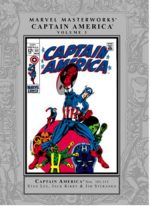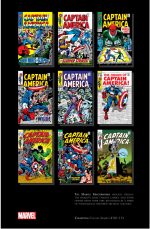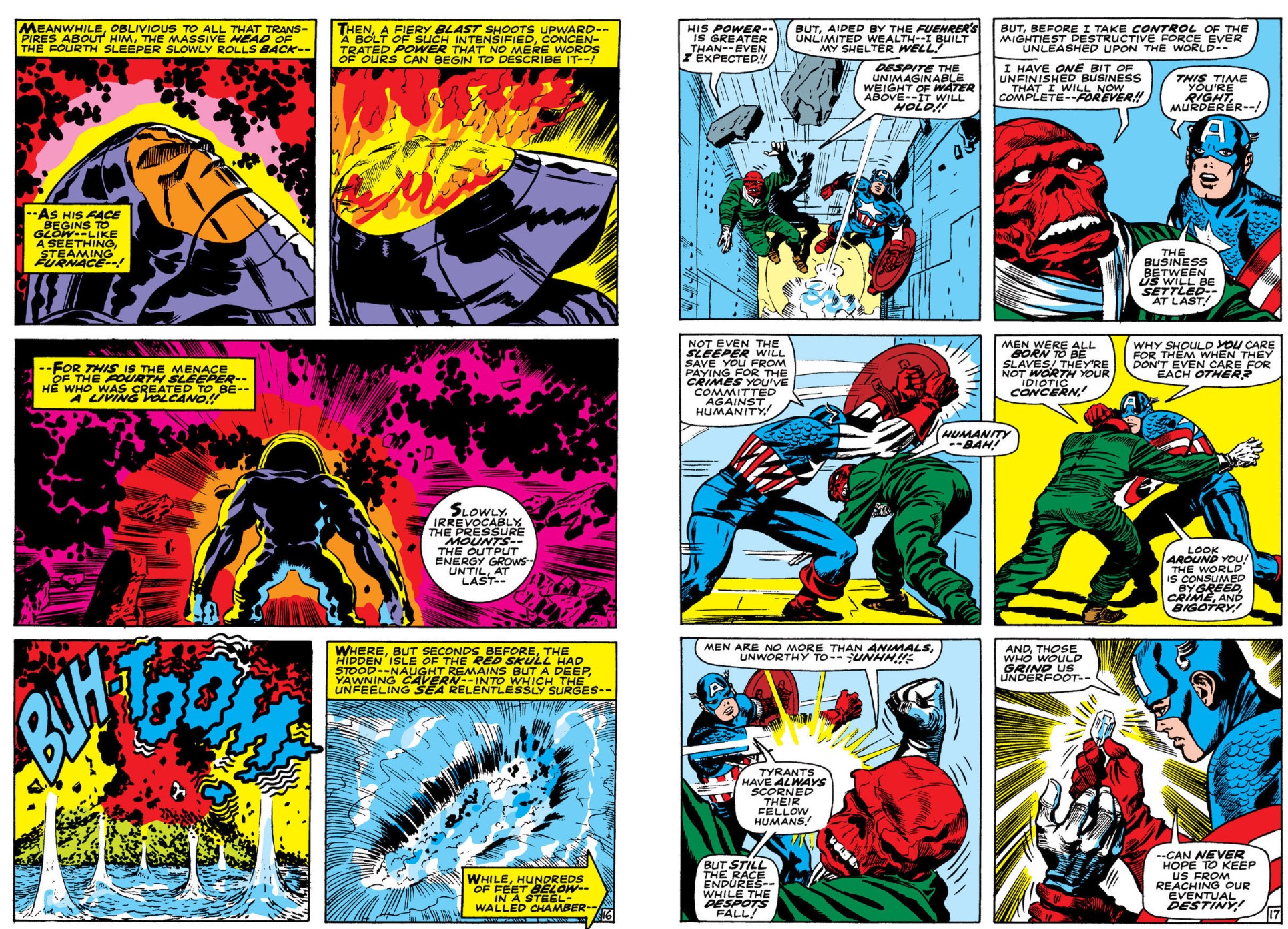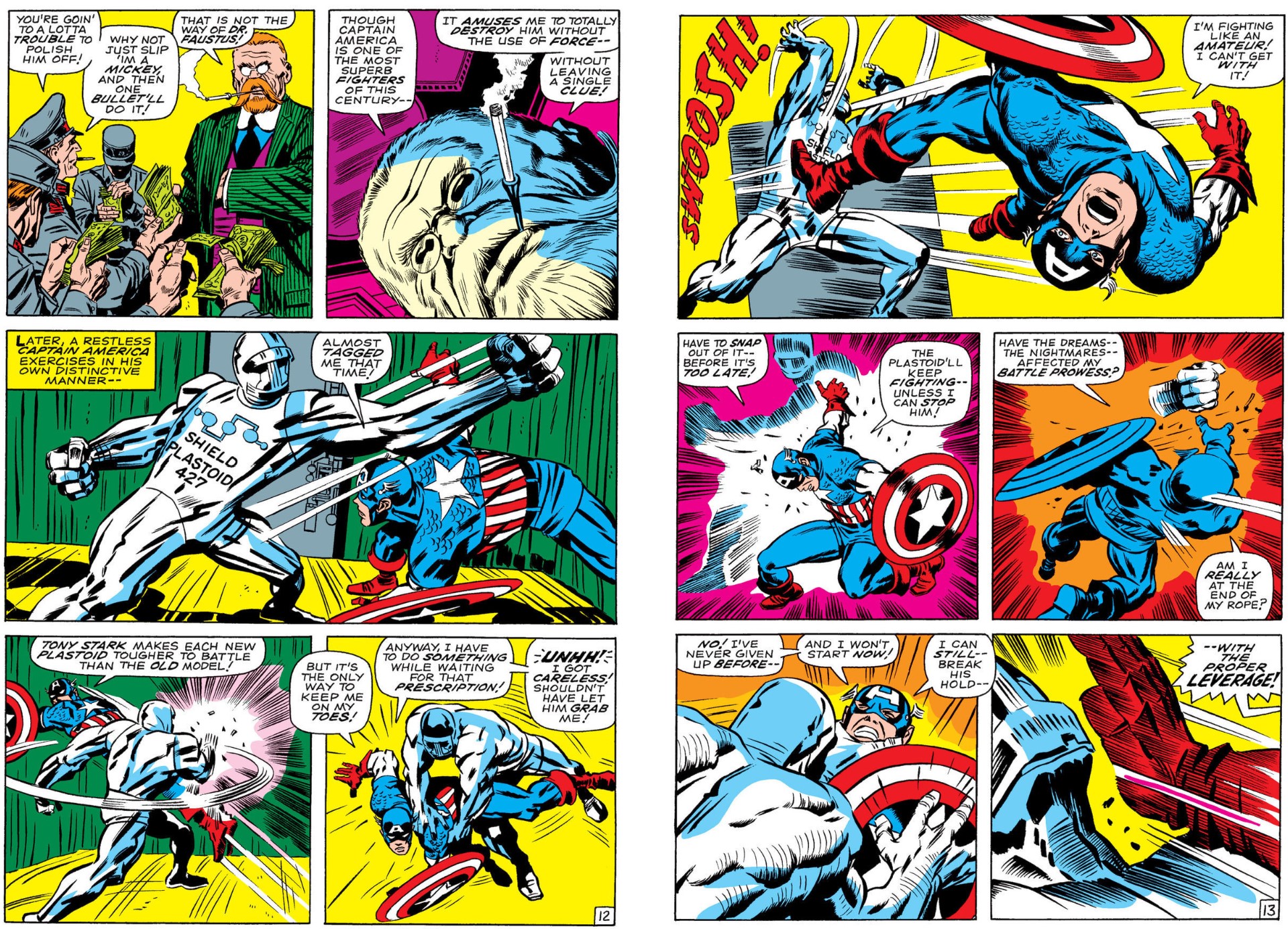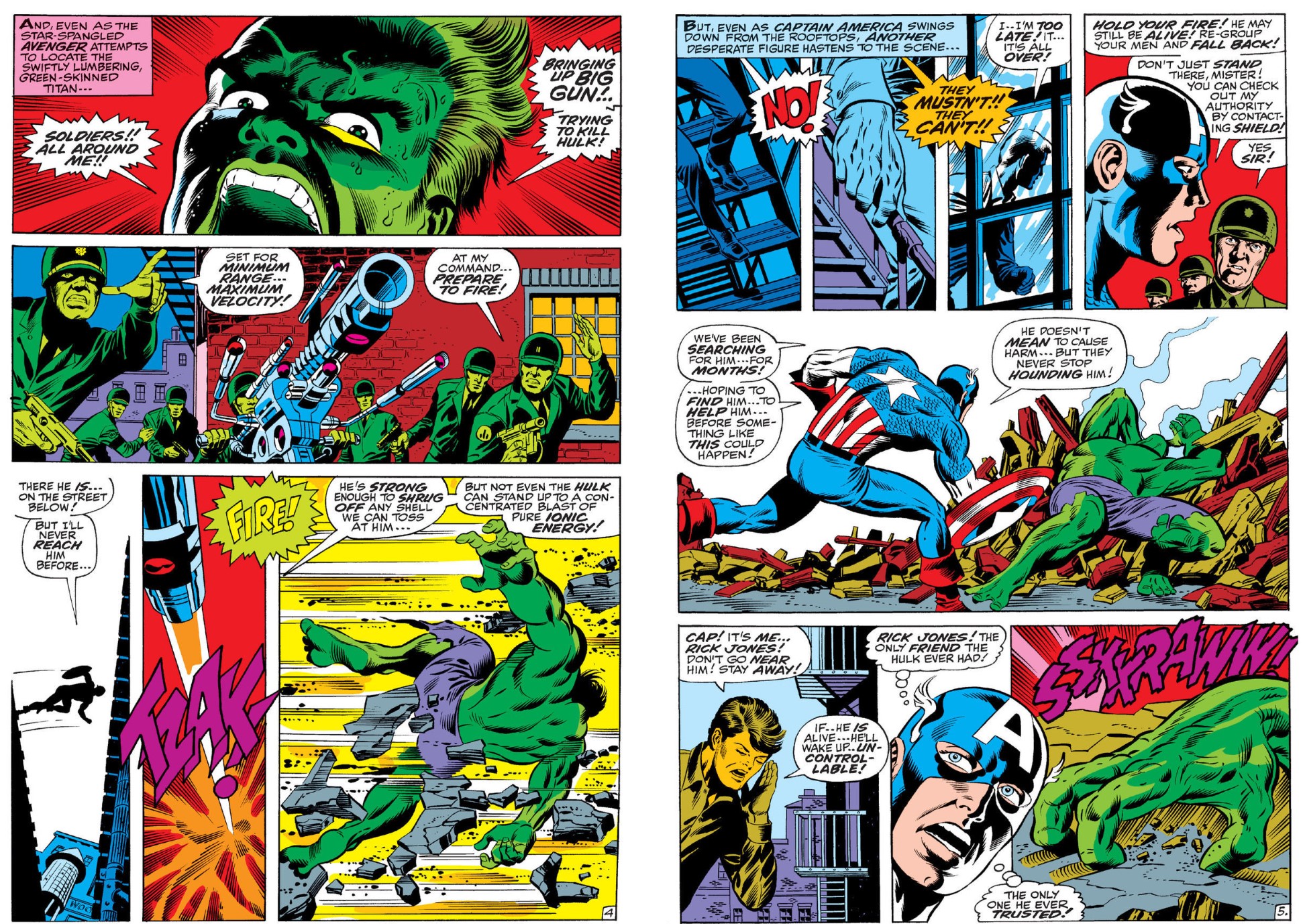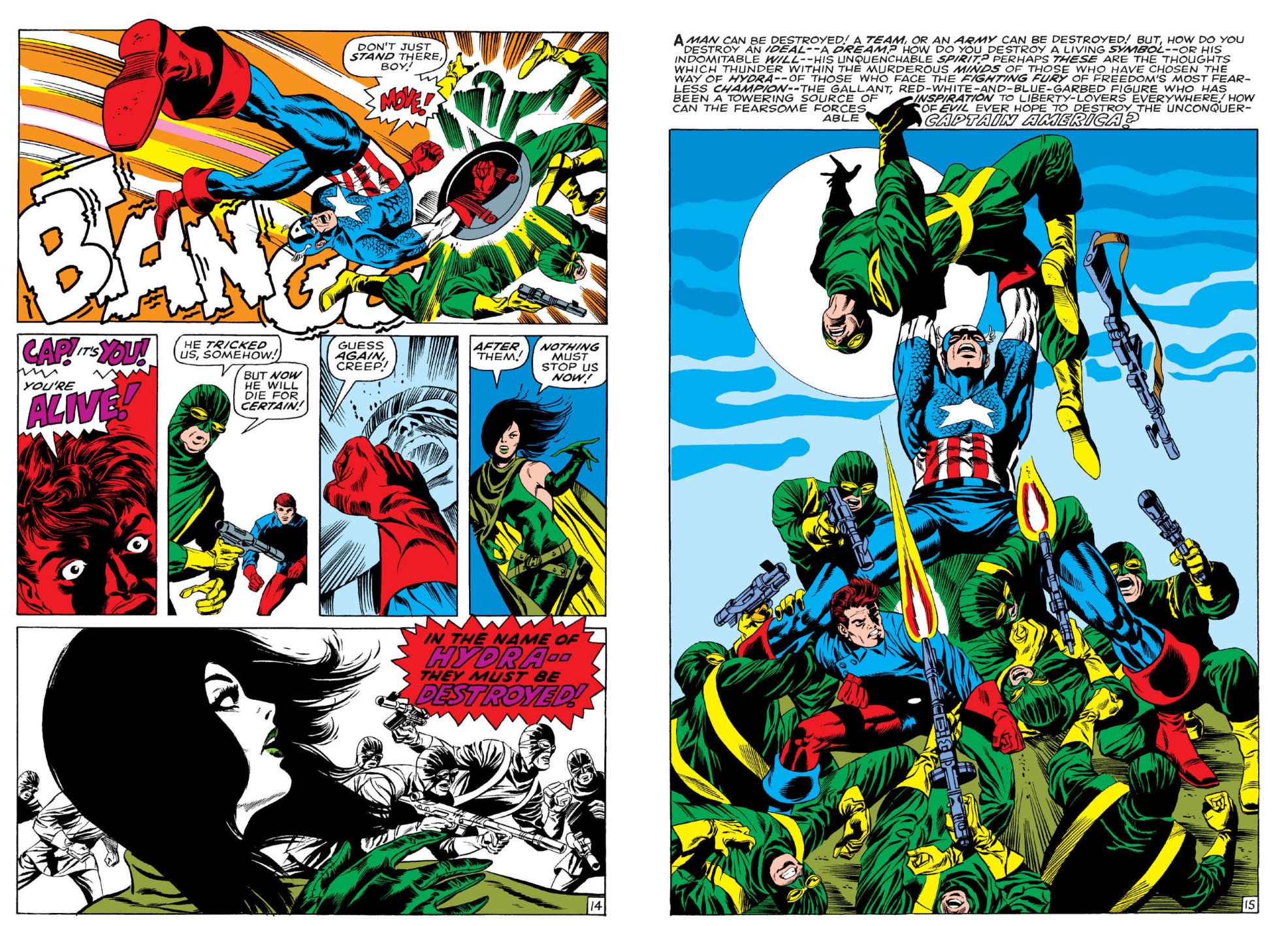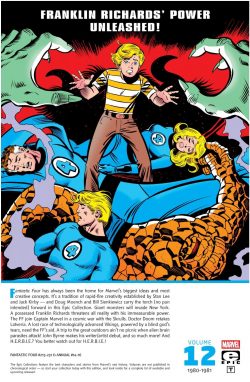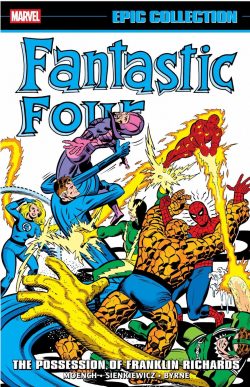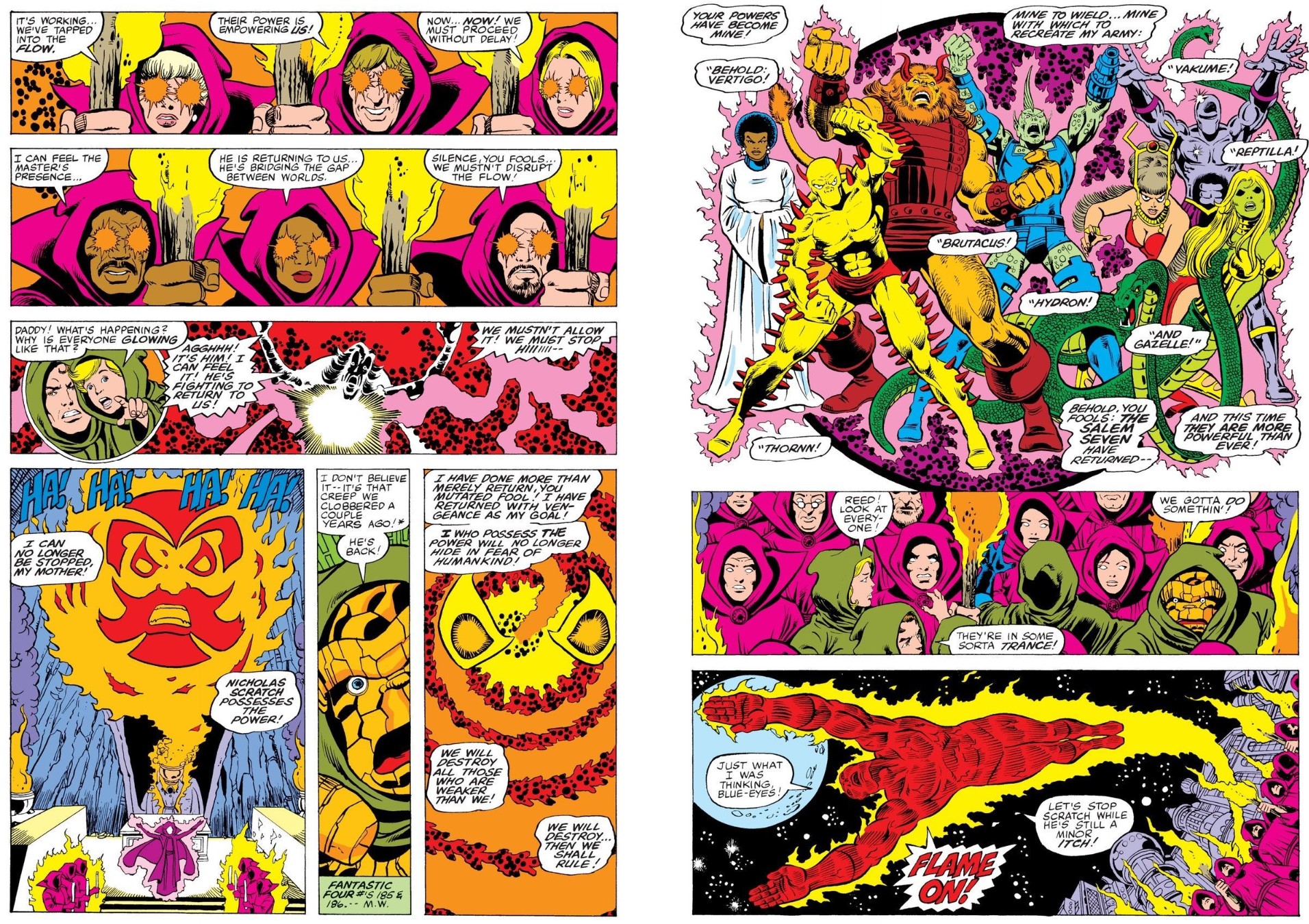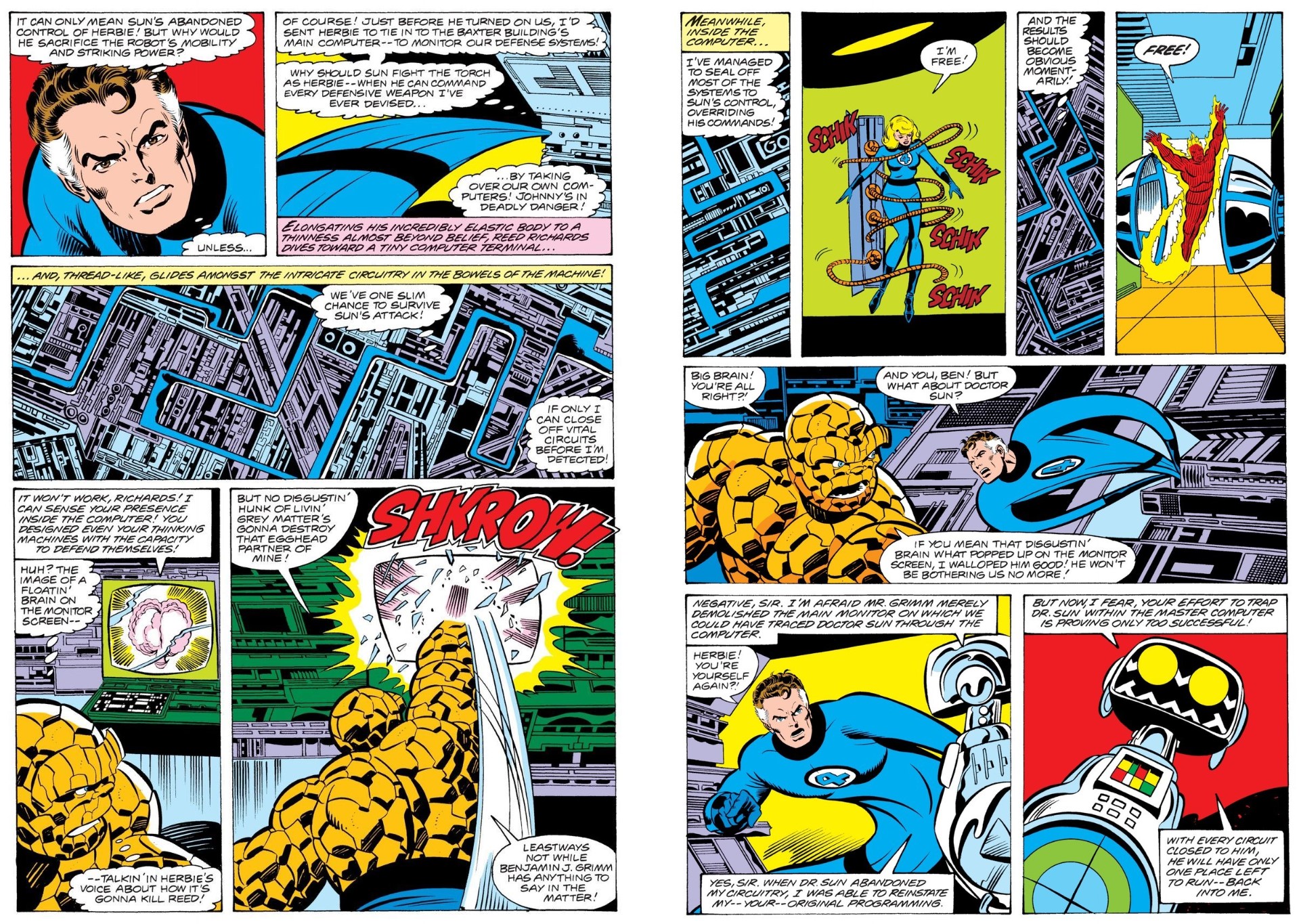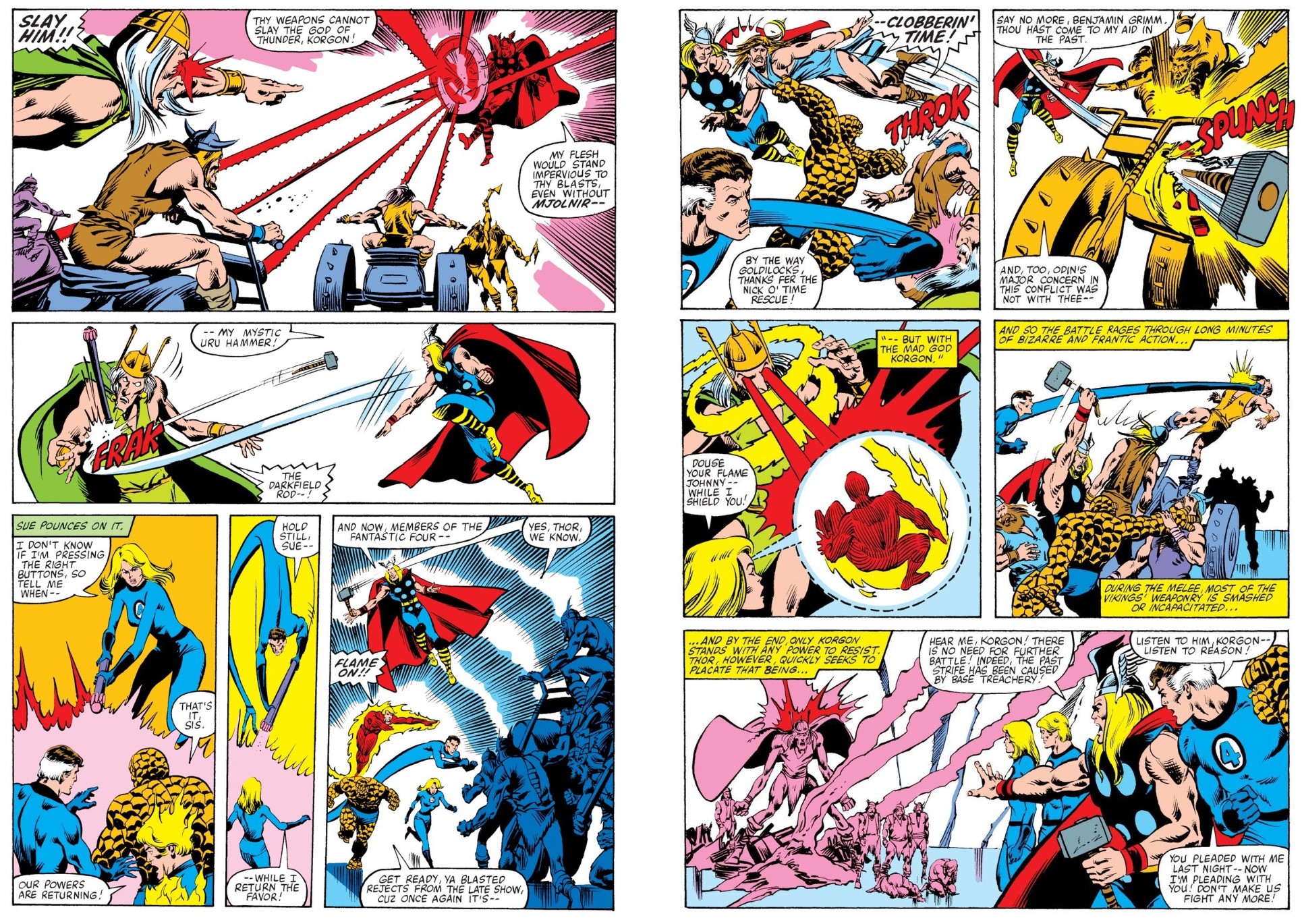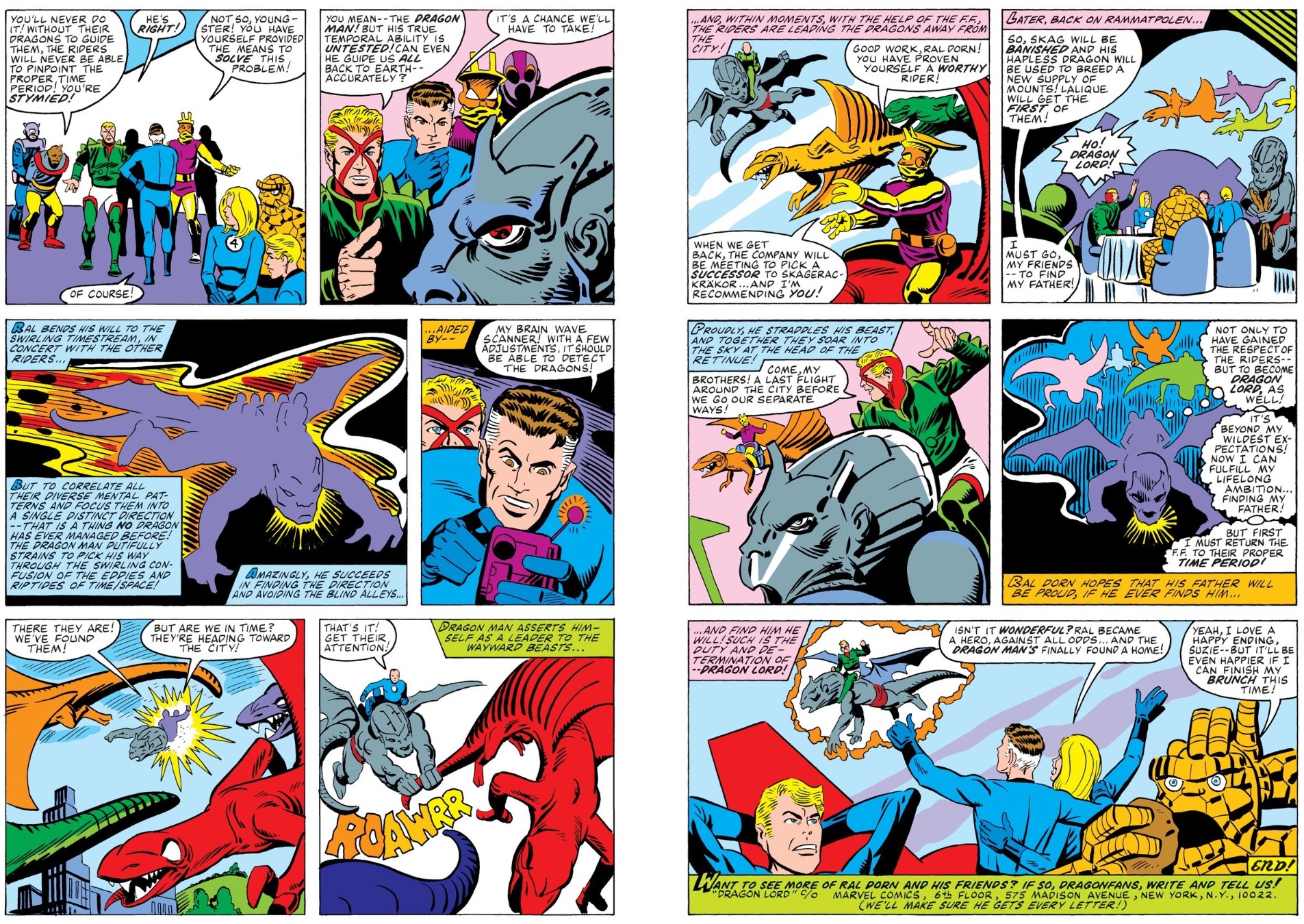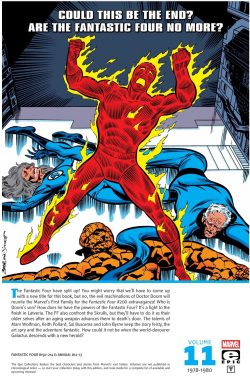
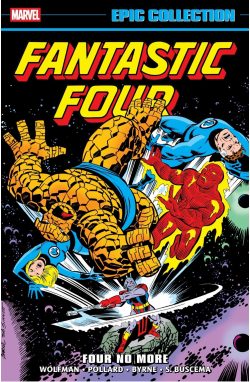
By Marv Wolfman, Bill Mantlo, Len Wein, Keith Pollard, Roger Slifer, John Byrne, Sal Buscema, George Pérez, Bob Hall, John Buscema, Joe Sinnott, Pablo Marcos, Bob Wiacek, Dave Hunt, Diverse Hands (Al Milgrom, Frank Giacoia, Frank Springer, Marie Severin), Bob Budiansky, Jack Kirby & various (MARVEL
ISBN: 978-1-3029-6055-1 (TPB/Digital edition)
This book includes Discriminatory Content from less enlightened times.
Win’s Christmas Gift Recommendation: Utter Acme of All-Ages Adventure… 8/10
For Marvel everything started with The Fantastic Four.
Monolithic modern Marvel truly began with the eccentric monster ‘n’ alien filled adventures of a compact superteam as much squabbling family as coolly capable costumed champions. Everything the company and brand is now stems from that quirky quartet and the inspired, inspirational, groundbreaking efforts of Stan Lee & Jack Kirby…
Cautiously bi-monthly and cover-dated November 1961, Fantastic Four #1 – by Stan, Jack, George Klein & Christopher Rule – was raw and crude even by the ailing outfit’s standards; but it seethed with rough, passionate, uncontrolled excitement. Thrill-hungry kids pounced on its dynamic storytelling and caught a wave of change beginning to build in America. It and every succeeding issue changed comics a little bit more… and forever. As seen in the premier issue, maverick scientist Reed Richards, his fiancée Sue Storm, their close friend Ben Grimm and Sue’s bratty teenaged brother survived an ill-starred private spaceshot after cosmic rays penetrated their ship’s inadequate shielding.
All four were permanently mutated: Richards’ body became elastic, diffident Sue became (even more) invisible, Johnny Storm burst into sentient living flame and poor tragic Ben shockingly devolved into a shambling, rocky freak. After initial revulsion and trauma passed, they solemnly agreed to use their abilities to benefit mankind. Thus was born The Fantastic Four.
Throughout the 1960s it was indisputably the key title and most consistently groundbreaking series of Marvel’s ever-unfolding web of cosmic creation: a forge for new concepts and characters. Kirby was approaching his creative peak: unleashing his vast imagination on plot after spectacular plot, and intense, incredible new characters whilst Lee scripted some of the most passionate superhero sagas ever seen. Both were on an unstoppable roll, at the height of their powers and full of the confidence only success brings, with The King particularly eager to see how far the genre and the medium could be pushed… which is rather ironic since it was the company’s reticence to give the artist more creative freedom that led to Kirby moving to National/DC in the 1970s.
Without Kirby’s soaring imagination the rollercoaster of mindbending High Concepts gave way to more traditional tales of characters in conflict, as soap opera schtick and supervillain-tirades dominated Fights ‘n’ Tights dramas. With Lee & Kirby long gone but their mark very much stamped onto every page of the still-prestigious title, this full-colour compendium reruns Fantastic Four #192-214 and Annuals #12-13, spanning March 1978-January 1980.
What You Should Know: After facing his own Counter Earth counterpart Reed Richards lost his stretching powers. With menaces like Salem’s Seven, Klaw and Molecule Man still coming for him and his family, weary and devoid of solutions, Richards made the only logical decision and called it a day for the team…
Incoming writer/editor Marv Wolfman, brought a new direction which closely referenced the good old days with #192 proclaiming ‘He Who Soweth the Wind…!’ (illustrated by George Pérez & Joe Sinnott), as newly independent, fancy-free Johnny heads west to revisit his childhood dream of being a race car driver and unexpectedly meets old pal Wyatt Wingfoot.
Back East, Ben and girlfriend Alicia Masters ponder options as Reed gets a pretty spectacular job offer from a mystery backer. Suddenly, though, Johnny’s race career is upended when superpowered mercenary Texas Twister attacks at the behest of a sinister but unspecified stalker with a grudge to settle…
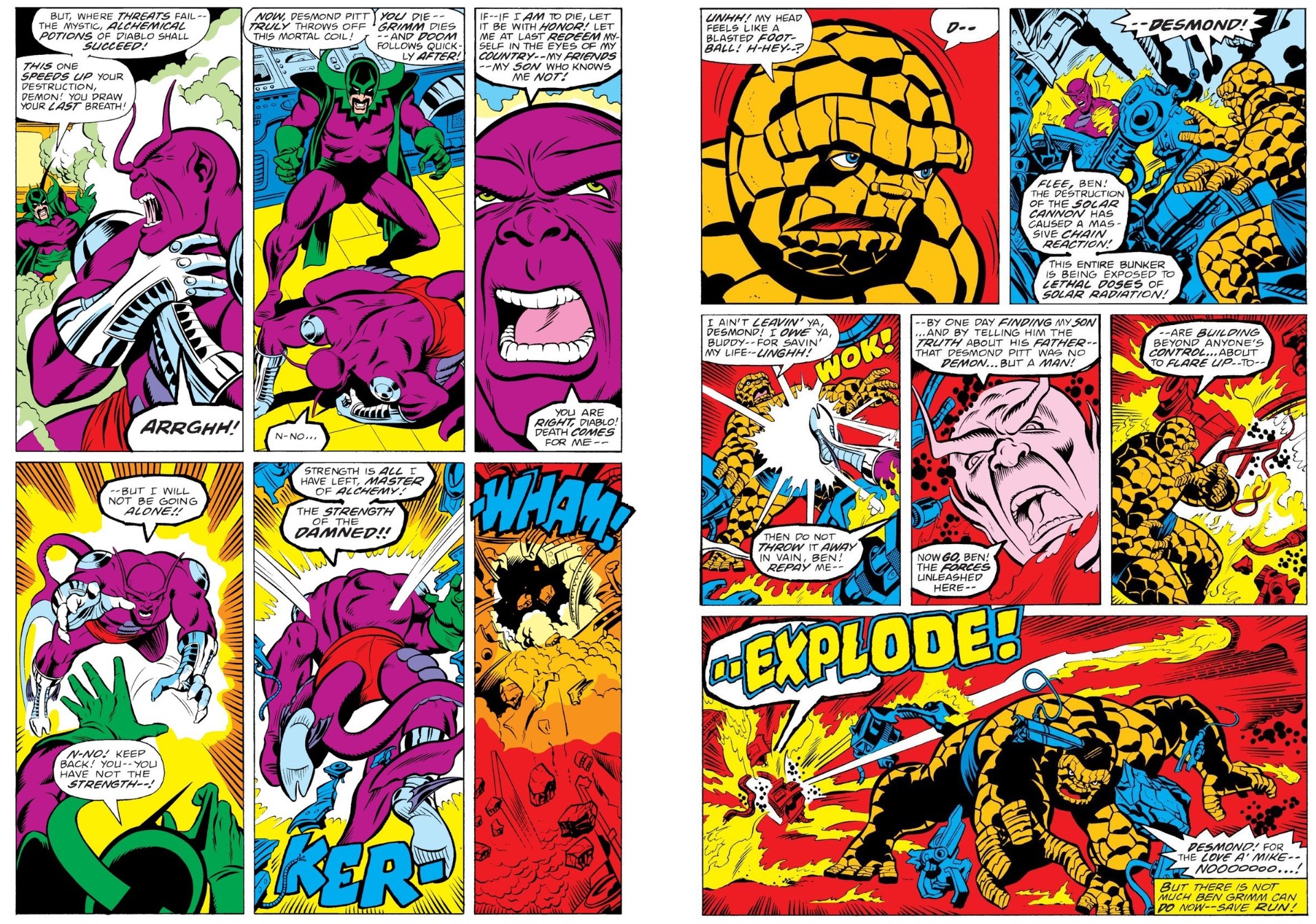
The admittedly half-hearted assault fails, but when Ben offers his services to NASA a pattern begins to emerge after he and Alicia are ambushed by old foe Darkoth in ‘Day of the Death-Demon!’ (plotted by Len Wein & Keith Pollard, scripted by Bill Mantlo, and illustrated by Pollard & Sinnott). The near-forgotten cyborg terror is determined to destroy an experimental solar shuttle, but doesn’t really know why, and as Ben ponders the inexplicable incident, in Hollywood, Susan Storm-Richards’ return to acting is inadvertently paused because alien shapeshifting loon the Impossible Man pays a visit. The delay gives Sue a little time to consider just how she got such a prestigious, dream-fulfilling offer so completely out of the blue at just the right moment…
At NASA, when Darkoth strikes again his silent partner is exposed as scheming alchemist Diablo, whilst in upstate New York, Reed slowly discovers his dreams of unlimited research time and facilities is nothing like he imagined. Finally, launch day comes and The Thing pilots the Solar Shuttle into space, only to have it catastrophically crash in the desert…
Joined by additional inker Dave Hunt, the creative pinch-hitters conclude the saga with ‘Vengeance is Mine!’ as Ben survives impact and searing sandstorms, tracks down his foes and delivers a crushing defeat to Diablo and Darkoth, whilst in FF #195 Sue learns who sponsored her revived Tinseltown ambitions when Prince Namor, The Sub-Mariner renews his amorous pursuit of her. Embittered and lonely, he has fully forsaken Atlantis and the overwhelming demands of his people and state. Sadly, they have not done with him and despatch robotic warriors to drag him back to his duties in ‘Beware the Ravaging Retrievers!’ (Wolfman, Pollard & Pablo Marcos). Like everybody else, the metal myrmidons have utterly underestimated The Invisible Girl and pay the price, allowing the once-&-future prince to reassess his position and make a momentous decision…
As Johnny links up with Ben & Alicia, strands of a complex scheme begin to appear. In #196 they gel for self-deceiving Reed Richards as ‘Who in the World is the Invincible Man?’ depicts the enigmatic Man with the Plan secretly subjecting Reed to the mind-bending powers of the Pyscho-Man, just as Sue rejoins Ben & Johnny in New York City before being impossibly ambushed by a former FF foe. This time the man under the hood is not her father, but someone she loves even more…
Reunited with Reed, the horrified heroes are confronted by their greatest, most implacable enemy and the complicated plot to restore Reed’s powers finally unfolds. Victor Von Doom craves revenge but refuses to triumph over a diminished foe, but his efforts to re-expose Richards to cosmic rays is secretly hijacked by a rival madman in ‘The Riotous Return of the Red Ghost!’ (Wolfman, Pollard & Sinnott). Of course there’s more at stake, as Doom also seeks to legitimise his rule through a proxy son: planning to abdicate in his scion’s favour and have Junior take Latveria into the UN and inevitably to the forefront of nations…
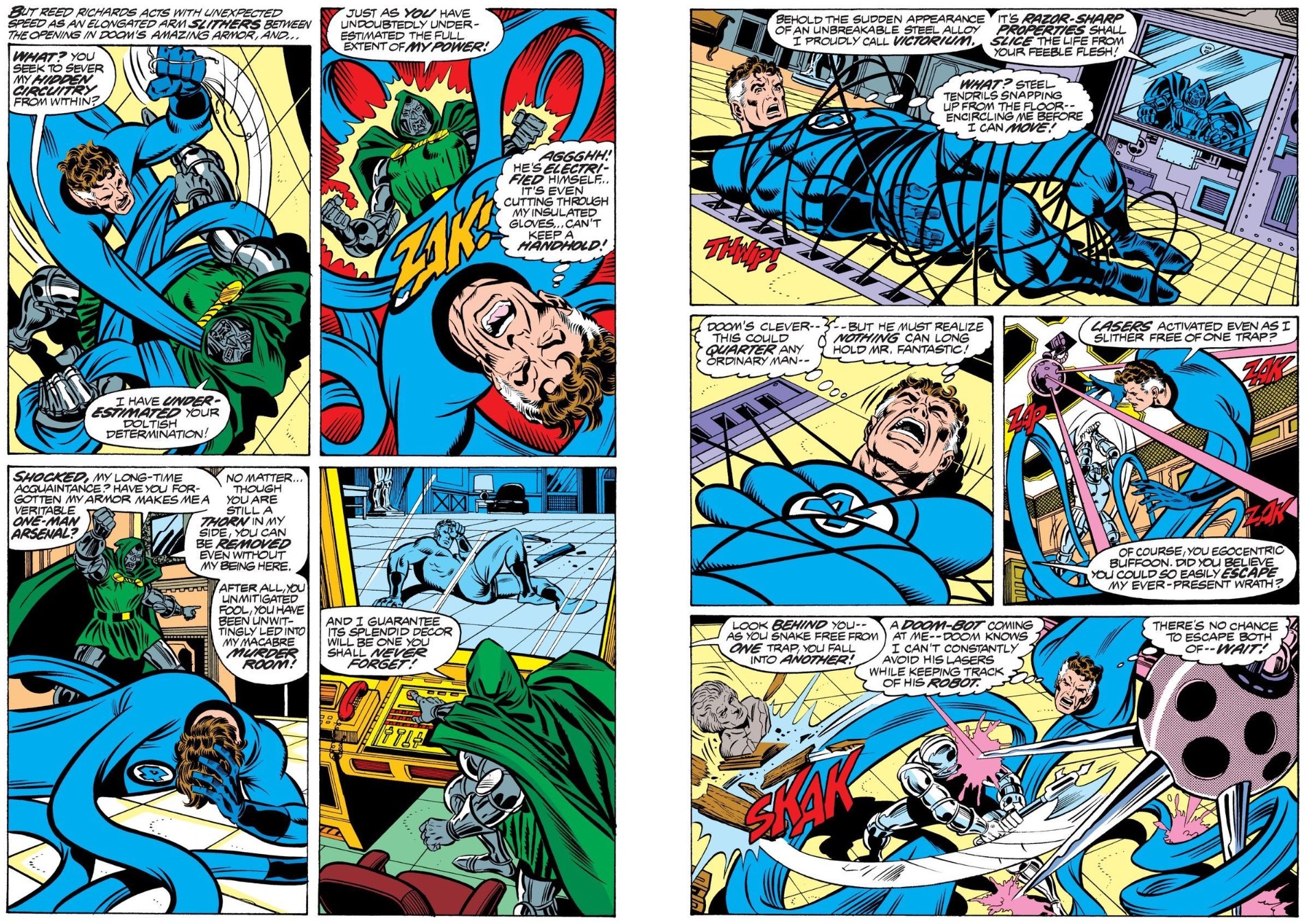
Fully restored and invigorated, Mister Fantastic defeats an equally resurgent Red Ghost before linking up with Nick Fury (senior) and S.H.I.E.L.D. to lead an ‘Invasion!’ of Doom’s captive kingdom. Beside Latverian freedom fighter/legal heir to the throne Prince Zorba Fortunov, Richards storms into Doomstadt, defeating all in his path and foiling the secondary scheme of imbuing the ‘The Son of Doctor Doom!’ with the powers of the (now) entire FF and exposing the incredible secret of Victor von Doom II…
Months of deft planning (from Wolfman, Pollard & Sinnott) culminate in epic confrontation ‘When Titans Clash!’, as Doom and Richards indulge in their ultimate battle (thus far), with the result that the villain is destroyed and the kingdom liberated. For now…
A post-Doom era opens in FF #201 (December 1978) as the celebrated and honoured foursome return to America and take possession of empty former HQ the Baxter Building. Unfortunately, so does something else, attacking the family through their own electronic installations and turning the towering “des res” into ‘Home Sweet Deadly Home!’: a mystery solved in the next issue when it subsequently seizes control of Tony Stark’s armour to attack the FF again in ‘There’s One Iron Man Too Many!’, with John Buscema filling in for penciller Pollard. The monthly mayhem pauses after #203’s ‘…And a Child Shall Slay Them!’ wherein Wolfman, Pollard & Sinnott reveal the incredible powers possessed by dying cosmic ray-mutated child Willie Evans Jr.
When the foremost authority on the phenomenon is called in to consult, Dr. Reed Richards and his associates – and all of Manhattan – face savage duplicates of themselves manifested from FF devotee Willie’s fevered imagination…
Although the regular fun pauses here, two chronologically adrift King-Size specials follow, beginning with Fantastic Four Annual #12’s ‘The End of the Inhumans… and the Fantastic Four’ (Wolfman, Bob Hall, Pollard, Bob Wiacek & Marie Severin. When Johnny’s former flame Crystal – and gigantic Good Boi Lockjaw – teleport in seeking aid in finding the abducted Inhuman Royal Family, the team confronts ruthless Inhuman supremacist Thraxon the Schemer before exposing that megalomaniac’s secret master: the immortal unconquerable Sphinx. Despite his god-like powers, the united force of the FF plus Blackbolt, Medusa, Gorgon, Triton, Crystal and former Avenger Quicksilver proves sufficient to temporarily defeat their foe… or does it?
A year later, Annual #13 offered a more intimate and human tale from Mantlo, Sal Buscema & Sinnott as ‘Nightlife’ revealed how New York’s lost underclass was systematically being disappeared from the hovels and streets they frequented. With cameos from Daredevil and witch queen Agatha Harkness, the tale reveals a softer side to the FF’s oldest enemy and a return to addressing social issues for the team.
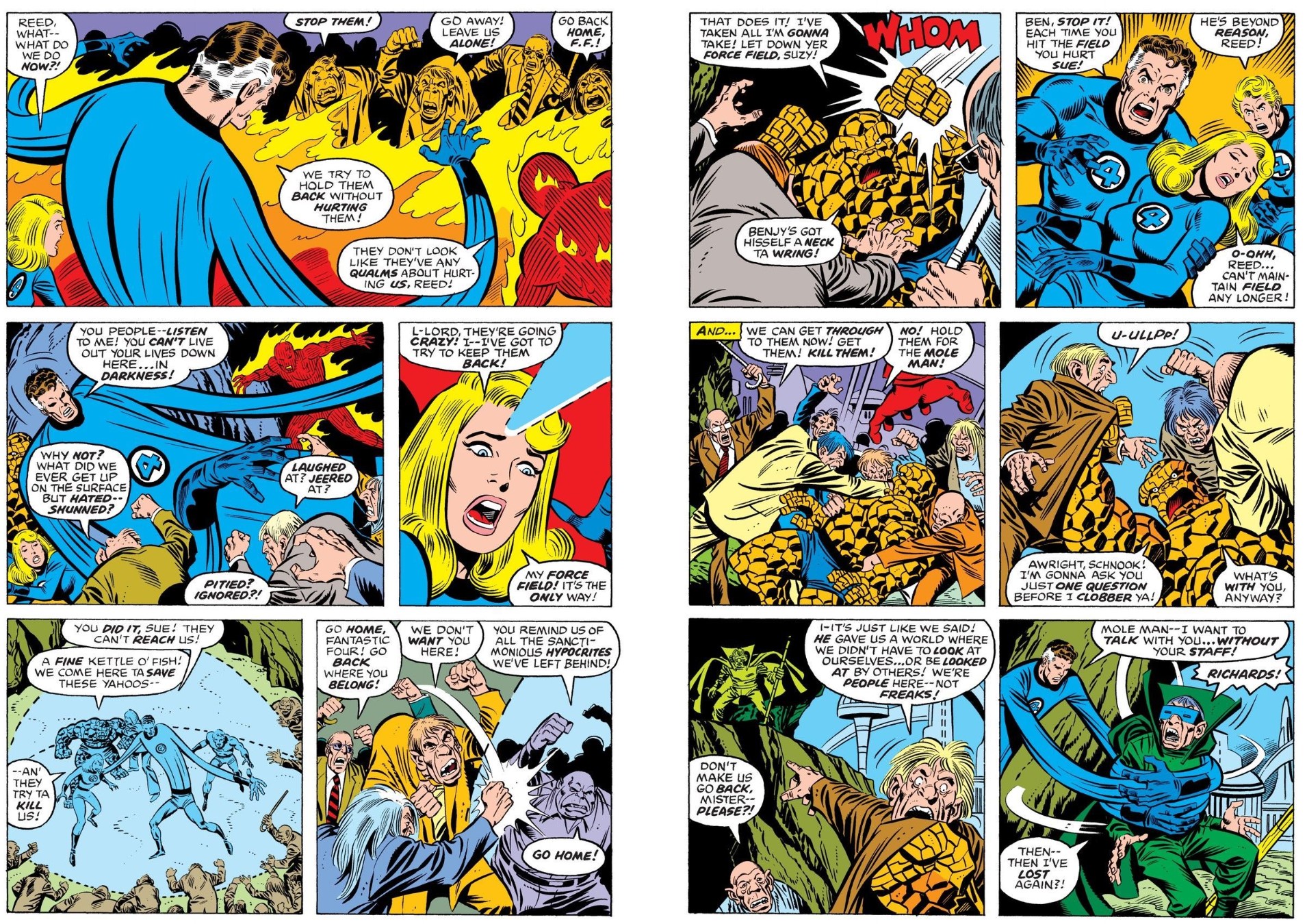
In monthly FF #204, Wolfman, Pollard & Sinnott detail ‘The Andromeda Attack!’ as Johnny goes out gallivanting and governess/guardian Agatha Harkness picks up little Franklin Richards, just as – with only grown-ups in residence – the building’s supercomputers pick up an astral anomaly, and materialise an alien princess in the lab. She’s instantly followed by a Super-Skrull who blasts her before falling to the FF’s counterattack. Interrogating the wounded woman, they learn she has come seeking help for her shattered world and near-extinct civilisation of Xandar…
Already illicitly supported by a Watcher breaking his oath of non-intervention, the last survivors of Andromeda’s most benign culture have been reduced to a quartet of domed stations linked together and careening through space, defended only by the last of their peacekeeper Nova Corps. Now the fugitives are being targeted for extinction by rapacious Skrulls and desperately need someone’s… anyone’s… assistance…
The FF are keen to help Suzerain Queen Adora return and happy to help the Xandarians, but the Human Torch has a new girlfriend and opts to stay behind for now to woo enigmatic Frankie Raye. He’s also set on finally following up on his long-postponed higher education commitments and has enrolled in specialist academic institution Security College. Naturally, Johnny promises to catch up later, but no sooner do his partners beam out to the stars than he’s attacked on campus by an old foe…
For #205, ‘When Worlds Die!’, Reed, Sue & Ben’s arrive with Adora at New Xandar finds the planetary remnants under attack by a Skrull war fleet, they join the Nova Corps to repel the assault, consequently driving closely-monitoring Skrull Emperor Dorrek insane with fury. Although Xandar’s physical resources are almost gone, he actually wants their greatest asset and treasure – a repository of their knowledge and power stored in an awesome array of superprocessors linking countless generations of expired citizens together: the Living Computers of Xandar! Chief administrator Prime Thoran and severely wounded Nova Centurion Tanak have been holding back the storm with ever-diminishing forces, but now need the FF to turn the tide, while back at Security College, Johnny has stumbled into mystery and peril too, as a strange force seizes control of the students…
In Andromeda, his family’s first foray against the Skrulls leads to their defeat and capture. Humiliated, tortured and put on display in a cruel show trial, they are ultimately blasted with a ray that will inescapably result in ‘The Death of… The Fantastic Four!’, rapidly aging them to the end of their natural lifespans in a matter of days. Dorrek’s gleeful gloating is spoiled, however, by the arrival of his terrifying, ambitious wife Empress R’kylll, the increased resistance of the Xandarians and, inevitably, the escape of the fast-aging Fantastic Four…
Ordering all-out assaults on the battered prey, Dorrek is further frustrated by Prime Thoran who gains astounding power by merging with the Living Computers of Xandar and the arrival of a colossal ship from Earth…
Here the saga dovetails with another Wolfman series that had recently ended its run on a cliffhanger. The Man Called Nova was in fact a boy named Richard Rider, a working-class nebbish in the tradition of Peter Parker, except he was good at sports and bad at learning, attending Harry S. Truman High School, where his strict dad was the principal. His mom worked as a police dispatcher and he had a younger brother, Robert, who was a bit of a genius. There were many more superficial similarities and cosmetic differences to Spider-Man. For more, you can either check out our numerous reviews or better yet, the actual comics tales, best seen in Nova Classic volumes #1-3. The 2-year saga culminated with Nova joining despised enemies The Sphinx (last seen battling the FF and Inhumans in Annual #12), Chinese superbrain-in-a-robot-body Doctor Sun, dastardly thug Diamondhead and hero-team The New Champions (The Comet, Crime-Buster and Xandarian refugee Powerhouse) aboard a pre-programmed, out-of-control spaceship hurtling towards Andromeda. Nova volume 1 ended with #25, with the unhappy crew lost in space and attacked by very angry Skrulls…
Meanwhile back at this review, those newcomers’ arrival piled on the pressure and concatenated the chaos as both the magical ancient immortal and futuristic Sino-cyborg abandoned ship, each determined to take the limitless power of Xandar’s Living Computer network for their own. Back on Earth for #207, Wolfman, Sal Buscema & Sinnott tune in on the Torch and favourite frenemy Spider-Man as they unite to expose the scandals of Security College, deprogram its students and almost fall foul of the sheer destructive ‘Might of the Monocle!’, after which the Torch joins his team in Andromeda. Aghast at the ongoing death sentence they’re enduring, Johnny is just as helpless before ‘The Power of The Sphinx!’ (Sal B & inking cavalry “D Hands” AKA Al Milgrom and Franks Giacoia & Springer) is boosted even further by stealing all the wisdom of the Living Computer system. With hyper-energised Prime Thoran busy battling Skrulls, the Sphinx soon solves the eternal secrets of the universe and heads back to Earth, resolved to turn back time and prevent his agonising eons of existence even happening, whilst seeing all reality endangered, increasingly elderly Reed has only one gambit to try…
John Byrne began his first tenure on the Fantastic Four with #209 (August 1979) as the reunited quartet seek to enlist the aid of cosmic devourer Galactus, pausing only long enough for Reed to construct – with Xandarian aid and resources – an all-purpose assistant. The result is the Humanoid Experimental Robot, B-type, Integrated Electronics (latterly, Highly Engineered Robot Built for Interdimensional Exploration; don’cha just love nominative deterministic acronymics?).
At this time, an FF cartoon show had rejected fire hazard Johnny for a cutely telegenic robot, and Wolfman cheekily made that commercial rejection in-world canon here, dividing fans forever after, as the bleeping bot is pure Marmite in most readers eyes…
Riding the mile-long starship Nova & Co arrived in, the FF’s search takes them across the universe before leaving them ‘Trapped in the Sargasso of Space!’ to face murderous aliens determined to use the new vessel to escape their stasis hell. Meanwhile, the New Champions and Xandar’s forces prepare to face their final battle, just as impatient R’kylll divorces her husband with a single ray gun blast and changes the course of history…
Despite odd, inexplicable increasingly hazardous incidences, the FF continue ‘In Search of Galactus!’ and at last locate him, causing chaos in his colossal world-ship. Ultimately, they convince the Devourer to stop the Sphinx, but only by rescinding the vow that prevents Galactus from consuming Earth, and if the humans first bring him a new herald…
That occurs in ‘If This Be Terrax’, on a distant world enslaved by brutal despot Tyros, when the pitiless killer is painfully subdued by the heroes and converted by Galactus into a being who will rejoice in finding worlds to consume irrespective of whether civilisations will be consumed with them…
In #212, Earth trembles as the Devourer unleashes his herald to cow humanity whilst his master faces The Sphinx, but ‘The Battle of the Titans!’ is subject to mission creep when the immortal Egyptian wizard sees his new knowledge as a way to restore his own past glories. With his master fully occupied in cosmic combat, Terrax the Tamer seeks to settle scores with the humans who toppled Tyros’ kingdom, only to fall ‘In Final Battle!’ for a ploy devised by Reed and executed by H.E.R.B.I.E. It’s the last hurrah and a massive “Hail Mary” ploy as Reed joins Sue and Ben in cryo-suspension, seconds from death, and barely aware that Galactus has triumphed, but at immense cost…
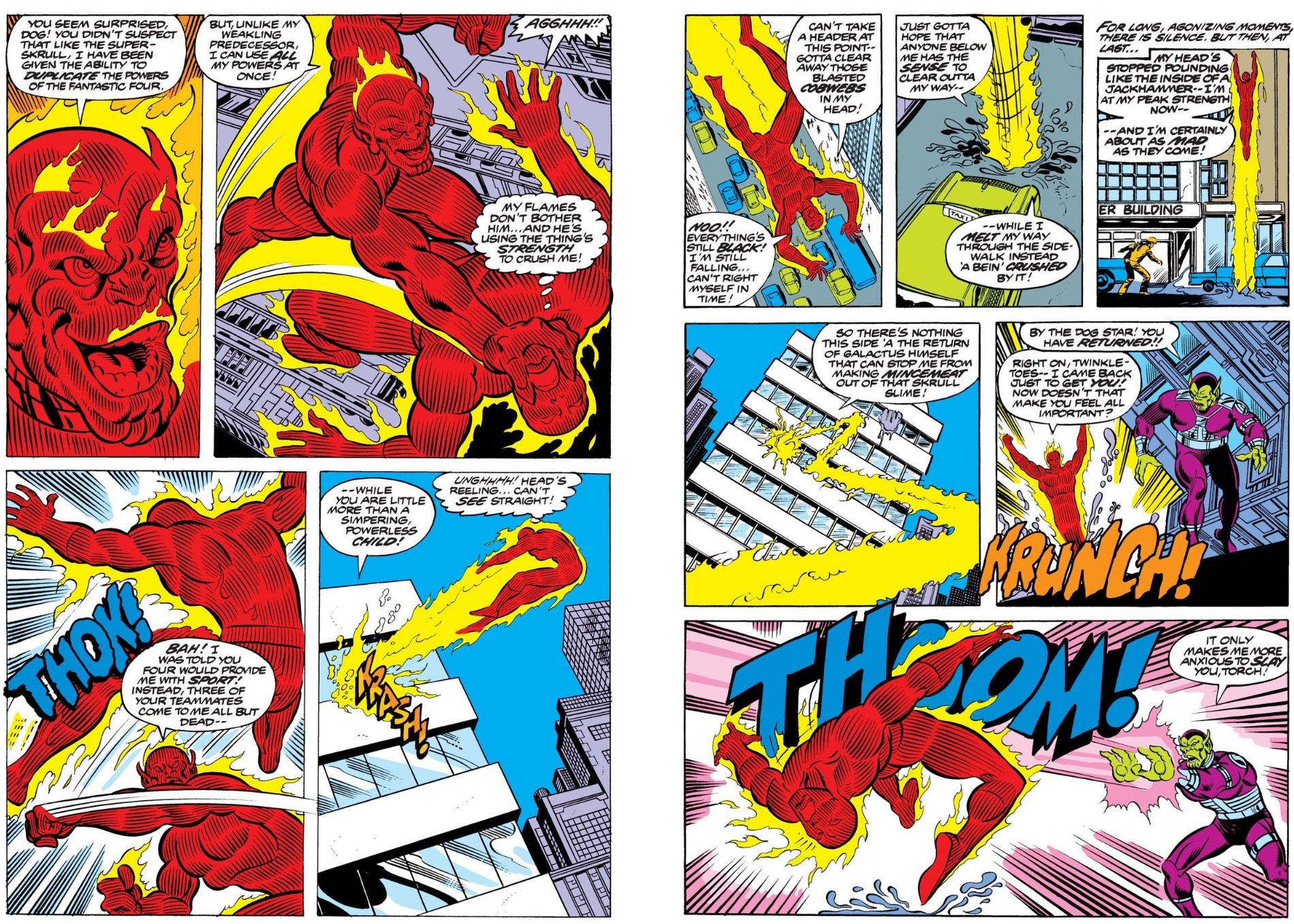
Tragedy becomes triumph in closing episode ‘…And Then There Was… One!’ (FF #214, January 1980) as Johnny frantically seeks a cure for his family. When S.H.I.E.L.D., The Avengers and any others all prove helpless, a fortuitous attack by vengeful cyborg Skrull-X offers a grain of hope, but one necessitating a huge gamble: defrosting Reed and hoping he can use what the defeated alien revealed before rampant decrepitude ends the Smartest Man on Earth…
Of course, it all works out, but for what comes next you’ll need the next volume…
Here the compilation concludes with bonus material supplementing all those fabulous covers by Pérez, Sinnott, Giacoia, Pollard, Marcos, John Buscema, Steve Leialoha, Kirby, Milgrom, Dave Cockrum, Walter Simonson, Byrne, Ron Wilson, Joe Rubinstein and Rich Buckler. It includes House ads for comics and the TV cartoon; editorial corrections; Cockrum’s cover rough for #197; Kirby & Sinnott’s original cover art for #200 and the covers for Marvel Treasury Edition #21 by Bobs Budiansky & McLeod.
Also on view are Budiansky’s pencils for the cover of F.O.O.M. #22 and the printed final result from Autumn 1978 as inked by Sinnott, plus interior features ‘HERBIE the Robot Blueprints!’ and ‘Stan Lee Presents: The Fantastic Four Cartoon Show’…
Although the “World’s Greatest Comics Magazine” never quite returned to the stratospheric heights of the Kirby era, this collection offers an appreciative and tantalising taste-echo of those heady heights and a potent promise of fresher thrills to come. These extremely capable efforts are probably most welcome to dedicated superhero fans and continuity freaks like me, but will still thrill and delight the generous and forgiving casual browser looking for an undemanding slice of graphic narrative excitement.
© 2025 MARVEL.
